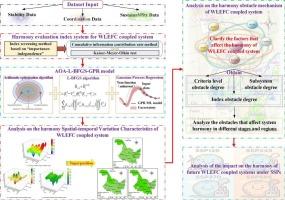基于混合高斯过程回归的水-陆-能-粮-碳耦合系统和谐评价
IF 6.3
1区 地球科学
Q1 ENGINEERING, CIVIL
引用次数: 0
摘要
生产要素与外部环境的协调是农业可持续发展的关键。然而,关于水-陆-能-粮-碳耦合系统的协调性的讨论仍然有限,导致其运行状态和制约因素不明确。本研究运用和谐理论对WLEFC系统进行检验。构建了和谐分析框架,完善了和谐分析评价指标体系。提出了一种将算法优化算法与有限内存BFGS算法相结合的改进高斯过程回归模型(AOA-L-BFGS-GPR)。该模型评价了黑龙江省WLEFC和谐的动态发展。我们确定了主要挑战并分析了趋势。流线型的指标系统使精确的测量成为可能。AOA-L-BFGS-GPR模型具有较高的精度、稳定性和合理性。1994 - 2023年,黑龙江省WLEFC系统和谐度由3.085增加到3.527。水资源子系统始终是主要障碍,其阻隔度保持在10%以上。后期,农村人口减少和节能进展缓慢成为重要的阻碍因素。大兴安岭和黑河农村空心化严重,农业人口阻隔度分别达到20.99%和17.43%。与此同时,东北城市面临着能源效率低和碳排放高的两大挑战。情景分析表明,SSP126路径比SSP245、SSP370和SSP585具有更好的绿色农业发展潜力。在SSP126路径下,预计到2055年,系统和谐度将达到3.923。该研究为分析WLEFC系统,支持环境可持续农业提供了新的见解和方法。本文章由计算机程序翻译,如有差异,请以英文原文为准。

Hybrid Gaussian process regression-based harmony assessment in a water–land–energy–food–carbon-emission coupled system
Harmonization between production factors and the external environment is crucial for sustainable agricultural development. However, discussions on the harmony of water–land–energy–food–carbon-emission (WLEFC) coupled systems remain limited, resulting in its operational status and constraints being unclear. This study used harmony theory to examine WLEFC systems. We also developed a harmony analysis framework and enhanced its evaluation index system. An improved Gaussian process regression model (AOA-L-BFGS-GPR) combining an arithmetic optimization algorithm with a limited-memory BFGS algorithm was developed. This model evaluated the dynamic development of WLEFC harmony in Heilongjiang Province, China. We identified key challenges and analyzed the trends. The streamlined index system allowed for precise measurements. The AOA-L-BFGS-GPR model demonstrated improved accuracy, stability, and reasonability. From 1994 to 2023, the WLEFC system harmony in Heilongjiang increased from 3.085 to 3.527. The water resource subsystem consistently remained the main obstacle, with its barrier degree remaining above 10%. Later in the period, rural population decline and slow progress in energy conservation became significant hindering factors. Daxing’anling and Heihe experienced severe rural hollowing, with the agricultural population barrier degrees reaching 20.99% and 17.43%, respectively. Meanwhile, northeastern cities faced two challenges: low energy efficiency and high carbon emissions. Scenario analysis showed that the SSP126 pathway provided better potential for green agricultural development than SSP245, SSP370, and SSP585. Under the SSP126 pathway, the system harmony was expected to reach 3.923 by 2055. This study offers new insights and methods for analyzing WLEFC systems, supporting environmentally sustainable agriculture.
求助全文
通过发布文献求助,成功后即可免费获取论文全文。
去求助
来源期刊

Journal of Hydrology
地学-地球科学综合
CiteScore
11.00
自引率
12.50%
发文量
1309
审稿时长
7.5 months
期刊介绍:
The Journal of Hydrology publishes original research papers and comprehensive reviews in all the subfields of the hydrological sciences including water based management and policy issues that impact on economics and society. These comprise, but are not limited to the physical, chemical, biogeochemical, stochastic and systems aspects of surface and groundwater hydrology, hydrometeorology and hydrogeology. Relevant topics incorporating the insights and methodologies of disciplines such as climatology, water resource systems, hydraulics, agrohydrology, geomorphology, soil science, instrumentation and remote sensing, civil and environmental engineering are included. Social science perspectives on hydrological problems such as resource and ecological economics, environmental sociology, psychology and behavioural science, management and policy analysis are also invited. Multi-and interdisciplinary analyses of hydrological problems are within scope. The science published in the Journal of Hydrology is relevant to catchment scales rather than exclusively to a local scale or site.
 求助内容:
求助内容: 应助结果提醒方式:
应助结果提醒方式:


